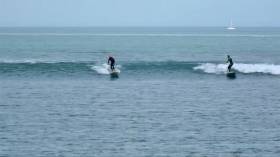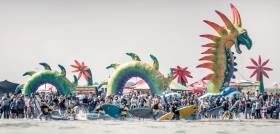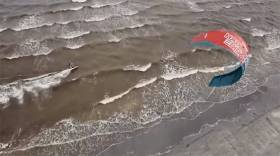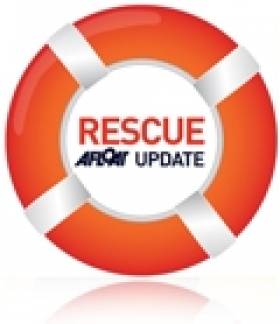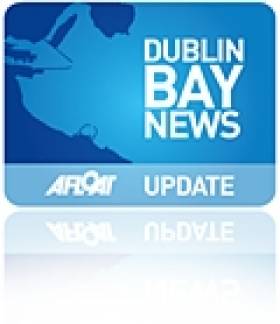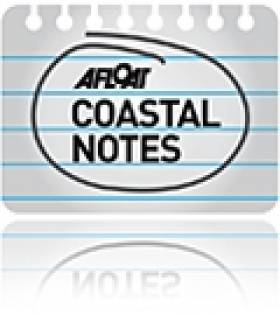Displaying items by tag: Dollymount
Beachgoers on the East Coast beware: lion’s mane jellyfish have been sighted in the waters off North Dublin, as DublinLive reports.
The venomous marine wildlife — which has previously prompted warnings for Dublin beaches — was recently spotted at Dollymount and in Portmarnock, where the carcass of an injured seal also washed up in recent days.
Lion’s mane jellyfish carry a painful and potentially lethal sting, even when washed up on the beach.
Two years ago a spate of incidents saw a number of swimmers hospitalised after being stung by lion’s manes in Galway Bay.
Ireland’s Longest Waves Make For Ferry Good Surfing In Dublin Bay
Ireland’s hottest surfing spot is… Dublin?
It might not be Mullaghmore, but many surfers swear by the waves off Dollymount Strand in Dublin Bay, widely believed to the the longest in Ireland.
Local kitesurfers already know the score — the location has hosted the Battle for the Bay for many years, after all.
And now SurferToday sings the praises of a ferry-powered surf spot perhaps little known beyond the tight-kit Irish wave community.
Dollymount Ready For Battle For The Bay This Weekend
#Kitesurfing - Fun, wind, water and fun are promised at this weekend’s Battle for the Bay kitesurfing and SUP competition on Dollymount Strand.
The best riders in the country and from around the globe will converge on Bull Island on Saturday 26 and Sunday 27 May to compete in the first leg of the IKSA tour at what organisers say is one of the best kitesurfing spots in the world.
All ages are welcome to cheer on the competitors, whether taking flight by kite or standing tall on their paddle boards.
Instructors will also be on hand to show you the ropes, while the food village, funfair and biodiversity area means there’s much more than the action on the waters of Dublin Bay.
For more see BattleForTheBay.com.
Dublin Beaches Closed To Swimmers After Liffey Sewage Spill
#Pollution - The beaches at Dollymount and Sandymount on Dublin Bay have been closed to swimmers after a sewage spill in the Liffey caused by heavy rain on Thursday (8 June).
According to BreakingNews.ie, swimming is banned at both of the popular city bathing spots pending the results from water samples expected tomorrow (Monday 12 June).
It comes just weeks after two Dublin region coastal beaches lost their Blue Flag status in the latest list of EU beach quality awards.
That announcement followed days from the news that three other Dublin beaches — including Merrion Strand, adjacent to Sandymount — had failed to meet the minimum standards for bathing water quality.
#BattleForTheBay - All ages are welcome to Dollymount Beach on the north side of Dublin Bay today (Saturday 28 May) for the 10th edition of kitesurfing weekender the Battle of the Bay.
Doubling as the first leg of kiteboarding's KBC Tour, the weekend will also host contests for stand up paddle boarding - with the action even branching out to the River Liffey tomorrow morning (Sunday 29 May) for the Dublin Bay SUP Classic.
Plus as always throughout the weekend there will be food and entertainment on the beach, including kiting and SUP lessons for kids, as well as beach volleyball and land yachting demonstrations.
For more details visit the Battle for the Bay website HERE. And see below for some of the action from last year's event:
#Kitesurfing - It's Battle for the Bay time on Dollymount Strand this weekend (23-24 May), and The 42 brings us a preview of the kitesurfing action you can expect on Bull Island today and tomorrow.
Cheering on the competitors from the beach will be Irish medal winner Jade O'Connor, who's currently campaigning for a spot at a future Olympics when the sport makes its debut (potentially at Tokyo 2020).
And in her role as ambassador, O'Connor also has high praise some of the other action in Dublin Bay's waters, via the related discipline of boardercross – essentially kitesurfing on an obstacle course – and the crowd-pleasing freestylers.
“It’s really visual and it’s about jumping really high, like up to 20 metres in the air and doing tricks,” says the current British Ladies Champion.
The 42 has more on the story HERE.
Hypothermic Casualty Rescued From Water At Dollymount
#Rescue - BreakingNews.ie reports on the rescue of a man from the water at Dollymount Strand on Monday morning (27 October).
Emergency services were dispatched to the scene after a passer-by expressed concern for a person seen in the cold water at the Bull Island beach.
Some 30 minutes later the casualty was sighted by Irish Coast Guard helicopter Rescue 116 and winched on board.
The man was found to be unconscious and diagnosed with severe hypothermia, and was taken to Beaumont Hospital for treatment.
Two days previous a similar alert at the same beach for a kitesurfer in difficulty was stood down, as the Irish Examiner reports, when the man in question was discovered to have made the lengthy swim back to shore.
Dollymount Car Ban Runs Afoul Of Ireland's Kitesurfers
#Dollymount - The news earlier this week that the temporary parking ban on Dollymount Strand will be made permanent has sent ripples among Ireland's kitesurfing community – many of whom are said to be snubbing what was a popular site for the sport in Dublin Bay.
That's according to Herald.ie, which also reports that the increase of kitesurfing visitors among other beachgoers "has created pressures with regard to maintenance, public order and safety" that prompted the car ban by Dublin City Council.
Nicola Murphy, secretary of the Irish Kite Surfing Association (ISKA), said the body wants to fully co-operate with the council" on finding a solution that will restore road access to the beach for its members.
Herald.ie has more on the story HERE.
Dollymount Car Ban To Be Made Permanent
#Dollymount - The Irish Times reports that a temporary ban on cars driving onto Dollymount Strand is to be made permanent by Dublin City Council.
The popular sandy stretch on Bull Island on the north side of Dublin Bay had been blocked off to traffic since June at its two entrances at the Bull Wall wooden bridge in Clontarf and the causeway to Raheny.
Councillors cited public safety concerns following an incident in which a woman was injured after her car was stuck in the sand, and which emergency services "had difficulty attending" due to "the haphazard nature of parking" on the beach.
The news has sparked upset among locals in Clontarf and Raheny, many of whom have frequented the beach by car for years without incident. The Irish Times has more on the story HERE.
#BLUE FLAGS - Dollymount Strand has regained its Blue Flag status in this year's round of awards, which sees the largest ever number of Irish beaches and marinas recognised.
The beach on north Dublin's Bull Island - which recently hosted Ireland's top kitesurfers for the 'Battle For The Bay' - once again flies the Blue Flag after losing it last year.
Also among the Dublin beaches receiving the EU accolade this year are Donabate, its first award since 2007, and Skerries south, which had not held Blue Flag status since 1995.
The news follows just weeks after Northern Ireland celebrated its own record year with 11 resorts receiving the coveted prize.
A total of 87 beaches and marinas around Ireland's coastline were awarded Blue Flag status this year, with some notable exceptions from the list.
As The Irish Times reports, Rush South and Malahide beach failed to make the cut, while in Cork, Claycastle Beach and the front strand at Yougal lost their flags.
And Mullaghmore in Sligo - an area now world-famous for its top-class surfing - lost out due to safety issues involving roaming livestock.
The Irish Times has more on the story HERE.




























